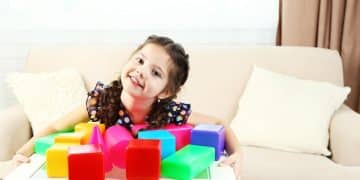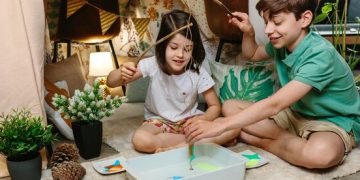Cultivating a Stimulating Home for Child Development
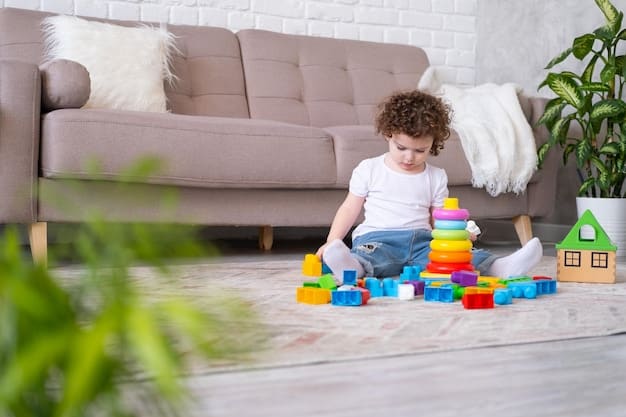
A stimulating home environment is crucial for fostering a child’s holistic development, offering a rich tapestry of experiences that engage their senses, challenge their minds, and encourage independent exploration, laying a strong foundation for future learning and well-being.
Understanding how to create a stimulating home environment for your child’s development is more than just providing toys; it’s about crafting an intentional space that nurtures curiosity, encourages exploration, and supports their intrinsic drive to learn. Such an environment doesn’t require elaborate setups or expensive gadgets, but rather thoughtful planning and consistent engagement.
Understanding the Foundations of Child Development in the Home
The home serves as a child’s first classroom and laboratory, a primary space where they develop cognitively, emotionally, socially, and physically. A stimulating environment is intentionally designed to support these developmental domains, moving beyond mere safety to actively promote growth and learning. It’s about recognizing that every interaction, every toy, and every corner of the house can contribute to a child’s emerging capabilities.
Creating such an environment begins with understanding the core principles of child development. Children learn best through play and exploration, meaning their surroundings should offer opportunities for both structured activities and spontaneous discovery. This foundational understanding allows parents to move past generic advice and tailor their approach to their child’s unique needs and developmental stage.
The Role of Sensory Engagement
Sensory experiences are fundamental to early brain development, as they help children process and understand the world around them. A stimulating home environment provides a rich array of sensory inputs, engaging touch, sight, sound, smell, and even taste in safe and age-appropriate ways. This isn’t about overstimulation, but rather offering diverse materials and opportunities for sensory exploration.
- Tactile Exploration: Offer various textures like soft blankets, rough natural objects, smooth wooden blocks, and squishy playdough.
- Visual Richness: Incorporate bright colors, diverse patterns, and visually interesting objects, but avoid chaotic clutter.
- Auditory Awareness: Introduce different sounds through musical instruments, nature sounds, and read-aloud stories, alongside quiet spaces for calm.
By consciously integrating sensory elements, parents can help their children develop crucial neurological pathways. It’s about providing materials that invite children to handle, observe, and listen actively, fostering a deeper connection with their surroundings.
Furthermore, understanding the evolving nature of a child’s developmental stages is key. What stimulates a toddler might overwhelm a newborn, and what challenges a preschooler might bore a school-aged child. Continuous observation and adaptation are critical to maintaining an environment that remains both responsive and challenging as the child grows.
Designing Play Zones and Learning Corners
Creating dedicated zones within the home for specific activities can significantly enhance a child’s ability to engage deeply with their environment. These areas act as invitations to play and learn, signalizing to the child that these activities are valued and encouraged. It doesn’t require a large house; even a small apartment can be partitioned creatively to serve multiple functions.
Crafting a Literacy Nook
A quiet, comfortable space dedicated to reading can instill a lifelong love of books. This isn’t just about throwing books in a bin; it involves intentional presentation and comfort. Consider low, accessible bookshelves, soft seating like a beanbag or cushions, and good lighting.
- Accessible Books: Ensure books are at a child’s eye level and easy for them to pick up independently.
- Comfortable Seating: A cozy chair or soft rug encourages prolonged engagement with stories.
- Variety: Include a mix of picture books, board books, and early readers, rotating them to maintain interest.
This dedicated space communicates the importance of reading and offers a tranquil retreat where imagination can flourish. It becomes a place associated with peaceful learning and shared moments, building positive associations with literacy.
Similarly, a creative arts station can spark imagination and fine motor skill development. Provide a dedicated table or corner with art supplies such as crayons, paper, child-safe scissors, playdough, and perhaps some washable paints. The key is accessibility and organization, allowing children to choose their materials independently and fostering a sense of agency over their creative endeavors. This continuous provision of diverse materials encourages experimentation and self-expression.
Transitioning between these zones throughout the day provides varied stimuli, preventing boredom and encouraging different types of engagement. A well-designed play zone isn’t just about what’s in it, but how it’s presented and how it invites interaction, making the environment dynamic and responsive to a child’s changing interests and developmental needs.
Incorporating Educational Materials and Activities
Beyond traditional toys, a truly stimulating home environment integrates educational materials that promote specific skills and cognitive growth. These materials don’t necessarily have to be overtly “educational”; often, everyday items can become powerful learning tools with a little creative thinking. The objective is to make learning an intrinsic part of daily life rather than a separate, scheduled activity.
Selecting Age-Appropriate Learning Tools
The effectiveness of educational materials hinges on their appropriateness for a child’s developmental stage. Too simple, and they bore; too complex, and they frustrate. Montessori-inspired tools, for instance, often excel at being self-correcting and engaging, encouraging independence and problem-solving.
- Infants (0-12 months): High-contrast cards, soft blocks, rattles, and simple mirrors for self-discovery.
- Toddlers (1-3 years): Shape sorters, simple puzzles, stacking cups, large art supplies, and practical life tools (e.g., small brooms).
- Preschoolers (3-5 years): More complex puzzles, building sets, counting materials, pre-writing tools, and early science kits.
Beyond specific tools, the integration of learning into daily routines significantly enhances stimulation. Cooking together can teach measurement and fractions, gardening can introduce biology and environmental concepts, and even simple chores can develop responsibility and fine motor skills. These real-world applications make learning tangible and meaningful.
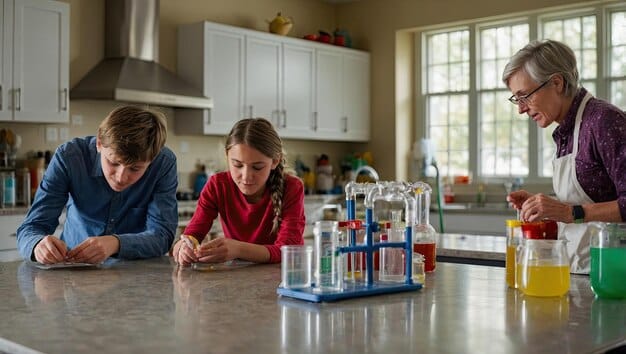
Encouraging open-ended play is another cornerstone. Materials that can be used in multiple ways—such as building blocks, loose parts, or dramatic play props—foster creativity, problem-solving, and imaginative thinking. These types of materials adapt as the child’s skills grow, ensuring long-term engagement and developmental benefits.
Furthermore, remember that parents are the most important educational material. Engaging in conversations, reading aloud, asking open-ended questions, and modeling curiosity about the world around them provide a constant stream of stimulation and demonstrate the joy of learning. This interaction transforms passive environments into active learning landscapes.
Fostering Independence and Autonomy
A stimulating home environment isn’t just about what’s available; it’s about how the child can interact with it. Central to holistic development is fostering independence and a sense of autonomy. When children feel capable and in control of their actions within their environment, they are more likely to explore, experiment, and learn. This involves creating spaces and routines that empower them to do things for themselves, within safe boundaries, rather than relying solely on adult assistance.
Creating Accessible Spaces
Making everyday items and learning materials accessible is paramount. This means ensuring that toys, books, and art supplies are at a child’s eye level and easy for them to retrieve and put away independently. Low shelves, light bins, and clear labeling can greatly facilitate this process, reducing frustration and encouraging self-management.
- Low shelving: Allows children to choose and return toys or books freely.
- Child-sized furniture: Empowers them to sit, work, and eat independently.
- Visual cues: Labels or pictures on bins help with organization and clean-up, fostering responsibility.
Beyond physical accessibility, providing choices is another powerful way to foster autonomy. Offering two appropriate options for an activity or snack allows the child to make a decision, which builds confidence and decision-making skills. This sense of agency is incredibly stimulating, as it connects their actions directly to outcomes, reinforcing their ability to impact their world.
The concept of “prepared environment,” often associated with the Montessori philosophy, emphasizes designing spaces where children can learn through self-directed activity. This includes practical life skills, like pouring water from a small pitcher or sweeping up crumbs, which build coordination, concentration, and a sense of contribution to the household. These practical experiences are just as stimulating and developmentally beneficial as academic endeavors.
Praise efforts rather than just outcomes, and allow for safe mistakes. When children are not afraid of failure, they are more likely to attempt new things and persist through challenges. This encourages a growth mindset, which is a crucial aspect of developing resilience and a love for learning in a stimulating home environment.
The Importance of Nature and Outdoor Play
While the focus is often on the indoor environment, a truly stimulating home extends beyond its walls to embrace nature and outdoor play. Exposure to natural environments is crucial for physical health, cognitive development, and emotional well-being. It provides unique sensory experiences, opportunities for gross motor skill development, and a natural classroom for scientific inquiry. The outdoor world offers unparalleled stimulation that cannot be fully replicated indoors.
Bringing Nature Indoors
Even if extensive outdoor spaces aren’t available, elements of nature can be brought into the home. Potted plants, a small herb garden on a windowsill, or a “nature table” displaying collected leaves, rocks, and pinecones can provide a calming, enriching connection to the natural world. These elements encourage observation, classification, and appreciation for living things.
- Indoor Plants: Introduce easy-to-care-for plants that children can help water and observe.
- Nature Collections: Create a designated spot for found natural objects, encouraging curiosity and connection to the outdoors.
- Nature Books: Fill shelves with books about animals, plants, and the natural world to extend learning.
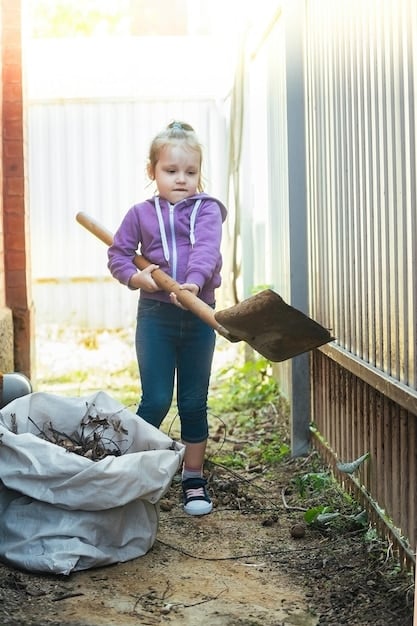
Outdoor play offers indispensable freedom for movement, which is vital for developing gross motor skills, balance, and coordination. Running, jumping, climbing, and exploring uneven terrain contribute directly to physical development and spatial awareness in ways that indoor environments typically cannot. The unpredictable nature of the outdoors also fosters adaptability and problem-solving skills, as children navigate different challenges.
Moreover, natural environments offer a wealth of sensory experiences—the smell of rain, the feel of mud between fingers, the sound of birds, the sight of changing seasons. These varied inputs contribute to a child’s sensory integration and their understanding of the world. Unstructured outdoor play often fosters creativity and imagination, as children use natural elements to invent their own games and narratives, free from the constraints of manufactured toys.
Creating a stimulating home environment means recognizing the reciprocal relationship between indoor and outdoor learning. It’s about providing safe, accessible outdoor spaces—whether a backyard, a balcony, or frequent trips to a local park—that complement indoor activities and offer a holistic developmental experience.
Balancing Stimulation with Calm and Routine
While the emphasis is on creating a stimulating environment, it is equally crucial to balance this with periods of calm, predictable routines, and opportunities for rest. Overstimulation can be as detrimental to development as under-stimulation, leading to irritability, difficulty concentrating, and disrupted sleep. A well-designed stimulating environment includes intentional spaces and times for quiet reflection and unwinding, ensuring that children have the capacity to process their experiences and consolidate learning.
Establishing Predictable Routines
Routines provide a sense of security and predictability, which are vital for a child’s emotional regulation and cognitive development. Knowing what to expect reduces anxiety and frees up mental energy for learning and exploration. While routines should allow for flexibility, a consistent rhythm for meals, play, learning, and rest contributes to a harmonious and stimulating home environment.
- Consistent Sleep Schedule: Essential for physical and cognitive restoration, allowing the brain to process daily inputs.
- Designated Quiet Time: Even if a child no longer naps, a period for independent quiet play or reading helps them recharge.
- Mindful Transitions: Give children notice before changing activities to help them adjust smoothly.
Creating “calm corners” or quiet spaces within the home is another effective strategy. This doesn’t need to be an entire room; it could be a cozy nook with soft cushions, a few quiet books, or sensory bottles. These spaces serve as a retreat when a child feels overwhelmed, offering a safe haven to self-regulate and find peace. The existence of such a space teaches children the importance of recognizing and responding to their own needs for calm.
Integrating downtime is not just about resting; it’s also about allowing for processing. Children need unstructured time to integrate new information, generate their own ideas, and engage in imaginative play without adult direction. This “boredom” is often the incubator for creativity and problem-solving, making it an invaluable part of a truly stimulating environment.
Ultimately, a finely tuned environment offers a dynamic interplay between active engagement and restful consolidation, ensuring that stimulation is absorbed effectively and contributes meaningfully to a child’s continuous development without leading to burnout.
| Key Aspect | Brief Description |
|---|---|
| 🎨 Play Zones | Designate areas for specific learning activities like literacy or art. |
| 📚 Educational Inputs | Integrate age-appropriate learning tools and real-world activities. |
| 👧🏽 Independence | Foster autonomy through accessible spaces and opportunities for choice. |
| 🌳 Nature & Calm | Incorporate natural elements and balance stimulation with calm routines. |
Frequently Asked Questions About Stimulating Home Environments
Environmental stimulation is immensely important for toddlers. During this rapid growth phase, well-designed environments encourage exploration, language acquisition, and motor skill development. Rich sensory experiences and opportunities for independent play are crucial for shaping neural pathways and laying the groundwork for complex cognitive functions, fostering curiosity and problem-solving abilities.
Yes, a home environment can absolutely be too stimulating. Excessive clutter, constant noise, or an overwhelming array of toys can lead to overstimulation in children, resulting in irritability, difficulty focusing, and poor sleep. It’s vital to balance exciting activities with calm, organized spaces and opportunities for quiet, unstructured play to allow children to process information effectively.
Low-cost ways include rotating toys to keep them fresh, using household items for play (pots and pans for music, blankets for forts), creating a reading nook with pillows, and incorporating nature elements like collected leaves or rocks. Utilize free library services for books and educational programs, and prioritize open-ended materials like cardboard boxes and art supplies for creative play.
Parental involvement is paramount. An environment’s potential for stimulation is fully realized when parents actively engage with their child, modeling curiosity, asking open-ended questions, and participating in play. Their interaction guides the child’s discoveries, provides emotional support, and tailors the environment’s response to the child’s evolving needs and interests, making the space truly dynamic.
In a multi-child home, it’s generally beneficial to have some specialized play areas for different ages to cater to distinct developmental needs. However, also include common areas where children of varying ages can engage in parallel or cooperative play. This approach ensures age-appropriate stimulation while fostering sibling interaction and shared experiences, promoting a harmonious and enriching family environment.
Conclusion
Creating a stimulating home environment for your child’s development is an ongoing, thoughtful process that profoundly impacts their growth across all domains. It’s not about material wealth or complex setups, but rather about intentionality—designing spaces that invite exploration, foster independence, and encourage a love for learning. By balancing diverse sensory inputs with opportunities for calm, incorporating nature, and, most importantly, dedicating engaged parental presence, you can cultivate a dynamic sanctuary where your child feels safe, supported, and endlessly curious, laying down enduring foundations for future well-being and lifelong learning.
